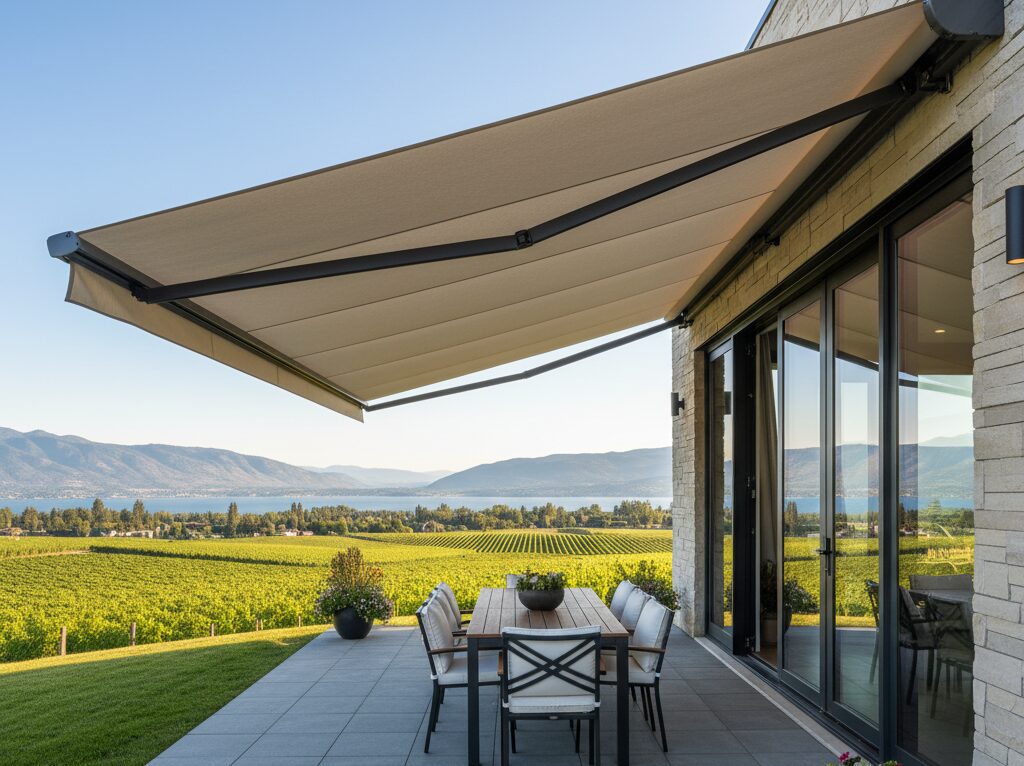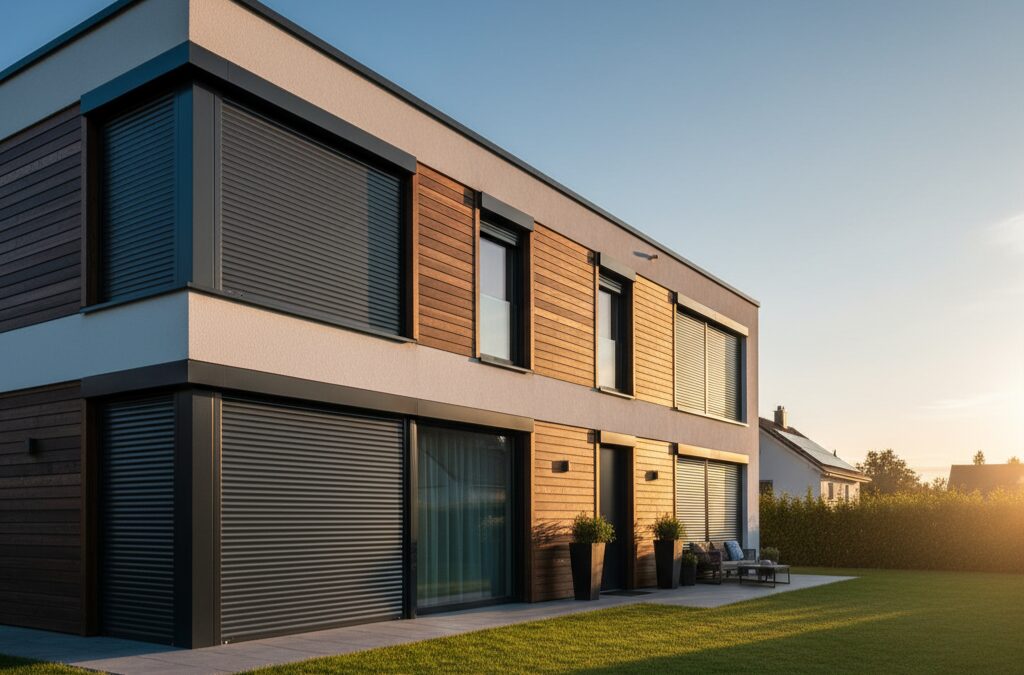Motorized vs Manual Rolling Shutters Which Is Right for You?
Choosing the right rolling shutters can transform your home’s security, comfort, and energy efficiency, particularly for Canadian homeowners dealing with harsh winters and hot summers. Homeowners must decide between manual roller shutters and motorized roller shutters, each offering distinct advantages.
This guide provides an in-depth look at their features, benefits, and practical considerations, including user convenience, installation cost, maintenance requirements, and climate-specific performance, helping you make an informed choice.
What Are Rolling Shutters?
Rolling shutters are versatile window coverings designed to protect homes from weather, enhance security, and improve energy efficiency. They consist of interlocking slats that can be raised or lowered to control light, airflow, and insulation. Both manual and motorized options are available to suit different homeowner needs, climates, and budgets.
Manual Roller Shutters
Manual roller shutters are traditional window coverings operated by hand. They are durable, require low maintenance requirements, and provide reliable insulation. Ideal for budget-conscious homeowners or locations with inconsistent power supply, they serve as effective security shutters against intrusions and environmental damage, including Canadian snowstorms and strong winds.
Motorized/Electric Roller Shutters
Motorized roller shutters, also known as electric roller shutters, use an electric motor and can be operated via remote control operation or home automation integration. Features like programmable timers, battery backup, and solar-powered shutters enhance convenience and accessibility, making them suitable for modern homes seeking user convenience and smart home compatibility. These shutters are particularly helpful in managing harsh seasonal temperatures.
Key Features Comparison
Ease of Use and Accessibility
Manual shutters require physical effort, which can be challenging for elderly or disabled individuals. Motorized shutters provide effortless operation through remotes, apps, or automated schedules, making them highly convenient for daily use and frequent adjustments in multi-story Canadian homes.
Security Features
Both shutter types improve home safety. Motorized shutters offer advanced safety features, including automatic locks and integration with alarm systems, while manual operation relies solely on physical security. Shutter automation enhances response time, protecting against break-ins during long winter nights.
Energy Efficiency
Motorized shutters help reduce energy bills through precise control of insulation and sunlight exposure. Programmable timers allow shutters to close during peak heat or cold, optimizing energy efficiency. In Canada, where winters can be extremely cold, motorized shutters help retain heat, reducing HVAC dependency. Manual shutters provide basic thermal protection but cannot adjust automatically.
Aesthetics and Design
Manual shutters come in a range of styles and finishes. Motorized shutters are sleek, integrate seamlessly with smart home systems, and allow aesthetic customization without compromising functionality. This is important for homeowners aiming to maintain curb appeal while enjoying modern convenience.
Durability and Weather Resistance
Both manual and motorized shutters are built for long-term durability & lifespan. They provide excellent weather resistance, withstanding snow, ice, and heavy rainfall. Motorized models require occasional maintenance to ensure the electric motor and automation components remain reliable in Canadian climates.
Installation and Cost
Manual shutters are cost-effective and simpler to install. Motorized shutters have higher installation cost due to wiring, motors, and potential home automation integration, but their convenience and energy efficiency may justify the investment over time, especially in regions with extreme seasonal temperature variations.
Pros and Cons: Weighing Your Options
| Feature | Manual Roller Shutters | Motorized/Electric Roller Shutters |
| Ease of Use | Requires manual effort | Effortless with remote or automation |
| User Convenience | Low | High, includes accessibility features |
| Security | Strong, reliable | Enhanced with automation and locks |
| Energy Efficiency | Basic insulation | Optimized with timers and automation |
| Installation Cost | Lower | Higher due to motor and wiring |
| Maintenance | Minimal | Periodic maintenance of motor and electronics |
| Power Dependency | None | Requires electricity, battery backup optional |
| Aesthetics | Various styles | Sleek, integrates with smart home |
| Durability | Long-lasting | Long-lasting with motor care |
Ideal Scenarios for Manual Shutters
Manual shutters are ideal for budget-conscious homeowners, properties with infrequent use, or areas with unreliable electricity. They provide excellent weather resistance, durability, and strong security features without relying on power. They perform well in Canadian homes that experience moderate seasonal changes.
Ideal Scenarios for Motorized Shutters
Motorized shutters suit homes with frequent use, accessibility requirements, or integration with smart home systems. They improve energy efficiency, provide remote control operation, and can include battery backup or solar-powered shutters for uninterrupted performance, especially during winter power outages.
Seasonal Considerations for Canadian Homes
Motorized shutters help retain heat during harsh winters, reducing energy consumption. In summer, they block excessive sunlight, supporting energy efficiency and natural cooling. They are ideal for homes in regions with extreme temperature fluctuations.
Noise Reduction Benefits
Rolling shutters, whether manual or motorized, provide noise reduction, minimizing the sound of traffic or wind. This feature is especially valuable in urban Canadian neighborhoods or near busy streets.
Maintenance Considerations
Manual shutters require minimal upkeep. Motorized shutters need periodic checks of the electric motor, remote systems, and backup power sources to maintain reliable performance and user convenience. Canadian homeowners should inspect for ice or snow build-up that might impact operation.
Long-Term Investment Value
Motorized shutters, while initially more expensive, can increase property value due to their convenience, integration with smart home systems, and energy-saving capabilities. Manual shutters offer a reliable, low-cost solution that protects homes effectively.
Tips for Choosing the Right Shutter
Assess your security features, energy efficiency, and ease of use needs. Consider installation cost, long-term maintenance requirements, durability & lifespan, and weather resistance. Choose shutters that align with your aesthetics & design preferences and smart home compatibility. For Canadian homeowners, consider seasonal performance, snow and ice resilience, and potential power outages when deciding between manual and motorized options.
Bottom Line
Selecting between manual roller shutters and motorized roller shutters depends on your budget, lifestyle, climate, and home requirements. Manual shutters offer reliability, affordability, and low maintenance requirements, while motorized shutters provide effortless user convenience, remote control operation, advanced security features, and improved energy efficiency. Understanding these aspects ensures you make the best choice to enhance your Canadian home’s safety, comfort, and efficiency.






